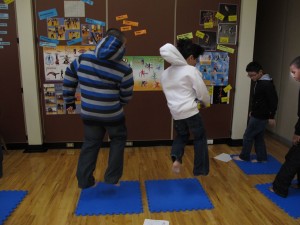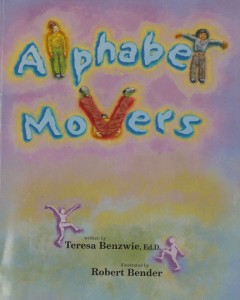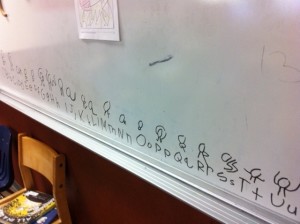I may be a dance specialist, but I’m no step dancer! Nonetheless, it’s been great to see my students working on precision footwork, thanks to Malke Rosenfeld’s Math in Your Feet unit, published last year in the Teaching Artist Journal (one of the sources I count as part of my Professional Learning Community). Through a quarterly periodical & ALT/space website, TAJ offers insight for me as a dance specialist in the public schools, despite the variety of perspectives covered by its authors, who represent all of the art disciplines & a variety of educational contexts. It’s a lively community, full of ideas and inspiration about arts education.
But the article “Jump Patterns: Percussive Dance and the Path to Math” (TAJ vol. 9, number 2, April-June 2011) provided much more than food for thought. The article unwraps the dance/math residencies Malke Rosenfeld teaches in public schools. The fact that she shares her methodologies with classroom teachers for use in the classroom lit a spark for me. Even without being a step dancer myself, maybe I could lead my dance students through the jump pattern curriculum!
I’m about to begin Week 5 of 6, finishing the jump patterns with my second set of 4th & 5th graders (six lessons per group), and we’re all enjoying it. Malke’s outline provided lots of material to work with, and I’ve worked the pacing & focus of instruction for each lesson to fit my ELL learners & my circumstance. The movement variables are broken into malleable chunks, and we’ve explored the math-related concepts of precision, congruency, reflection, and turn symmetry, with students choreographing patterns in teams of 2 and 3. In addition to integrating dance & math, there’s a problem-solving (choreography) component that parallels the “workshop/conferencing” structure that my students are familiar with through Writers Workshop, allowing me time to confer with & jump-start individual students. In addition, there’s a spatial arrangement that supports classroom management (personal dance spaces for each team — wow, what a concept!). Add in some dance videos to “mentor” the kids in their choreographic process & journaling questions to provide feedback on what students are learning, and it’s no wonder we’re all engaged!
My first groups of 4th & 5th graders finished the unit before the holiday break, with some of them performing their patterns, both congruently & in mirror symmetry. They nailed the precision steps they’d created, even without the support of their personal dance spaces, and their peer audience was able to talk about what they were seeing with insight and new vocabulary. What a pleasure to watch… I’m so grateful to be able to learn from colleagues!





